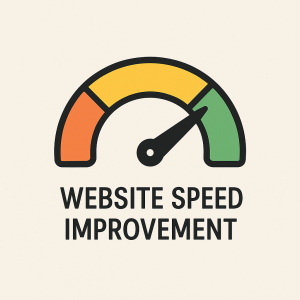
Introduction
In today’s fast-paced digital world, website speed is more critical than ever. Users expect pages to load instantly, and if your website fails to meet these expectations, they are likely to abandon it for a competitor. According to Google, as page load time goes from one to three seconds, the probability of bounce increases by 32%. Beyond user experience, site speed is also a ranking factor for SEO, impacting your visibility on search engines.
In this article, we will explore practical and effective ways to improve your website’s loading speed, ensuring better performance, improved search rankings, and higher conversions for your business.
Why is Website Speed So Important?
1. User Experience
Fast-loading websites provide a better user experience. Visitors are more likely to stay, explore, and take action on your site if it loads quickly. A slow website leads to frustration, damaging your brand’s reputation and reducing return visits.
2. SEO Rankings
Google uses website speed as a ranking factor. Faster websites are prioritised in search results, increasing organic traffic. Improving your site’s loading time can significantly boost your SEO performance.
3. Conversion Rates
Speed impacts conversion rates directly. Studies by Amazon and Walmart show that even a one-second delay in load time can result in a 1% decrease in sales. For small businesses, this could mean lost opportunities and revenue.
How to Test Your Website’s Loading Speed
Before making changes, test your current website speed using tools such as:
- Google PageSpeed Insights
- GTmetrix
- Pingdom Tools
These tools provide a detailed breakdown of what is slowing your site down and suggestions for improvement.
Practical Ways to Improve Your Website’s Loading Speed
1. Optimise Images
Large image files are one of the biggest culprits of slow websites.
✅ Compress Images: Use tools like TinyPNG or ShortPixel to reduce image file size without noticeable quality loss.
✅ Use the Right Format: For photographs, use JPEG; for graphics and icons, use PNG or SVG.
✅ Enable Lazy Loading: This ensures images load only when they enter the viewport, reducing initial page load time.
2. Minimise HTTP Requests
Each element on your website (images, scripts, stylesheets) requires an HTTP request. Reduce these by:
✅ Combining CSS and JS files
✅ Using CSS Sprites for icons
✅ Removing unnecessary plugins and scripts
3. Enable Browser Caching
Browser caching stores website data on a visitor’s browser so that it doesn’t have to reload every element each time they visit. This significantly improves repeat visitor load times.
To enable browser caching, adjust your .htaccess file (if using Apache) or configure your server settings. If unsure, ask your hosting provider for assistance.
4. Use a Content Delivery Network (CDN)
A CDN stores copies of your website on servers around the world, ensuring that visitors load your site from the server nearest to them. This reduces latency and speeds up load time, especially for international visitors.
Popular CDN services include Cloudflare, Amazon CloudFront, and StackPath.
5. Minify CSS, JavaScript, and HTML
Minification removes unnecessary characters and spaces from your code files, reducing their size and speeding up load times. Plugins like Autoptimize (WordPress) or build tools like UglifyJS can automate this.
6. Choose a Reliable Hosting Provider
Your hosting provider plays a critical role in site speed. Shared hosting often struggles with speed during peak traffic times.
✅ Upgrade to Managed Hosting or VPS: Faster processing power and dedicated resources improve performance.
✅ Use Local Servers: Choose a hosting provider with servers in your country for local businesses.
👉 Explore TownHost’s hosting and development services for fast, reliable website performance: TownHost Hosting and Development
7. Reduce Redirects
Each redirect creates additional HTTP requests, slowing your website down. Audit your site and remove unnecessary redirects where possible.
8. Enable GZIP Compression
GZIP compresses website files before sending them to the browser, reducing their size and improving loading speed. Most hosting providers support GZIP compression by default, but you can enable it via your .htaccess file or plugins like WP Rocket.
9. Optimise Your Database
Over time, your website’s database can become cluttered with old data, slowing down performance.
✅ Clean Up Post Revisions: Delete unnecessary revisions of pages and posts.
✅ Delete Unused Plugins and Themes: This reduces database bloat.
✅ Use Optimisation Plugins: For WordPress, plugins like WP-Optimize streamline your database.
10. Implement AMP (Accelerated Mobile Pages)
AMP provides a stripped-down version of your site for mobile users, loading almost instantly. This improves mobile SEO and user experience, especially if a large portion of your audience accesses your site via mobile devices.
11. Monitor Performance Regularly
Website speed optimisation is not a one-off task. Monitor your site’s performance regularly to ensure it continues to load efficiently as you add new content and features.
Conclusion
Website speed is vital for user experience, SEO, and conversions. By implementing the strategies above, you can ensure your website loads quickly and efficiently, providing visitors with a seamless experience that encourages engagement and boosts business growth.
If you need expert support to improve your website’s loading speed, TownHost’s hosting and development services are here to help you build a faster, more reliable website. Visit TownHost Hosting and Development to learn more.
#WebsiteSpeed #LoadingSpeed #WebDevelopment #SEO #BusinessGrowth #WebsiteTips #TownHost #WebsiteOptimisation #DigitalMarketing #WebHosting
